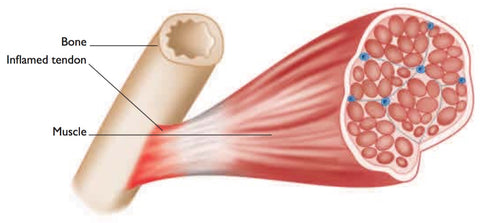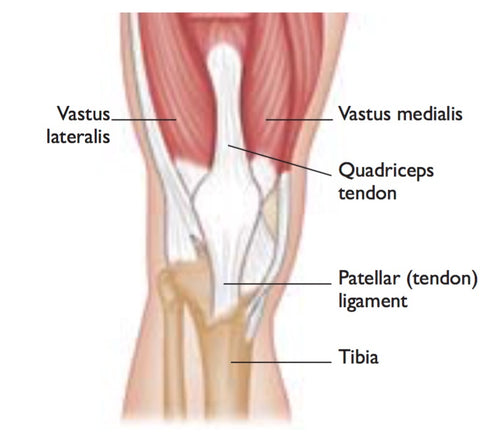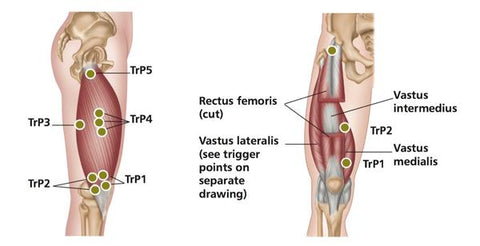Trigger Point Therapy - Quadriceps Tendinitis
Trigger Points - Stretching the Quadricep Muscles
Inflammation of the quadriceps tendon can be a result of repetitive stress to the quadriceps or excessive stress before the muscle is conditioned
Minor tears may occur in the tendon when it is stretched while subjected to loading. Pain just above the patella (kneecap), especially when extending (straightening) the knee, usually accompanies this injury.
Cause of injury
Repetitive stress to the tendon, e.g. running or jumping. Repetitive acceleration and deceleration, e.g. hurdling or football. Untreated injury to the quadriceps.

Signs and symptoms
Pain just above the patella. Jumping, running, kneeling or walking down stairs may aggravate the pain.
Complications if left unattended
The quadriceps muscles may become stiff and shortened and the tendon will become weak if left untreated. This could lead to a rupture of the tendon. A change in gait or landing form in the case of hurdlers can lead to other injuries as well.

Immediate treatment
Rest and ice. Anti-inflammatory medication. Training modification.
Rehabilitation and prevention
Rehabilitation should include stretching and strengthening exercises for the quadriceps. Activities such as swimming can be helpful to reduce the stress on the tendon during rehabilitation.
Return to a normal activity schedule should be delayed until pain subsides completely and strength is restored. Keeping the quadriceps flexible and strong will help prevent this condition. Even healthy quadriceps tend to be "loaded" with trigger points, and trigger therapy is a must for both prevention and rehabilitation (see below).
Long-term prognosis
A full recovery with no long-term disability or lingering effects can be expected in most cases of tendinitis.

Trigger Points
Trigger points in the quadriceps are incredibly common and in the most part ignored as these powerful and robust muscles continue on with their daily work. Over time trigger points in the quads may lead to a number of complications elsewhere in the body.
When they become active, pain from trigger points in the quads involves a deep toothache-like pain (vastus medialis) in the knee joint, or on the lateral or medial aspect of the thigh, including the knee.
In addition to being a contributing factor in quadriceps strains, these trigger points are likely to become active immediately following any injury to the quadriceps, as part of the body's protect and defend mechanism. Failure to address these trigger points may prolong the recovery period and create additional complications further down the line.
Find a Trigger Point Professional in your area
Dry Needling for Trigger Points
Certify as a Trigger Point Therapist
NAT Online Trigger Point Courses:
This trigger point therapy blog is intended to be used for information purposes only and is not intended to be used for medical diagnosis or treatment or to substitute for a medical diagnosis and/or treatment rendered or prescribed by a physician or competent healthcare professional. This information is designed as educational material, but should not be taken as a recommendation for treatment of any particular person or patient. Always consult your physician if you think you need treatment or if you feel unwell.

About Niel Asher Education
Niel Asher Education (NAT Global Campus) is a globally recognised provider of high-quality professional learning for hands-on health and movement practitioners. Through an extensive catalogue of expert-led online courses, NAT delivers continuing education for massage therapists, supporting both newly qualified and highly experienced professionals with practical, clinically relevant training designed for real-world practice.
Beyond massage therapy, Niel Asher Education offers comprehensive continuing education for physical therapists, continuing education for athletic trainers, continuing education for chiropractors, and continuing education for rehabilitation professionals working across a wide range of clinical, sports, and wellness environments. Courses span manual therapy, movement, rehabilitation, pain management, integrative therapies, and practitioner self-care, with content presented by respected educators and clinicians from around the world.
Known for its high production values and practitioner-focused approach, Niel Asher Education emphasises clarity, practical application, and professional integrity. Its online learning model allows practitioners to study at their own pace while earning recognised certificates and maintaining ongoing professional development requirements, making continuing education accessible regardless of location or schedule.
Through partnerships with leading educational platforms and organisations worldwide, Niel Asher Education continues to expand access to trusted, high-quality continuing education for massage therapists, continuing education for physical therapists, continuing education for athletic trainers, continuing education for chiropractors, and continuing education for rehabilitation professionals, supporting lifelong learning and professional excellence across the global therapy community.

Continuing Professional Education
Looking for Massage Therapy CEUs, PT and ATC continuing education, chiropractic CE, or advanced manual therapy training? Explore our evidence-based online courses designed for hands-on professionals.




















